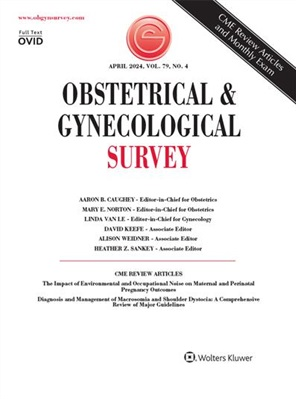Cesarean Delivery Trends Among Patients at Low Risk for Cesarean Delivery in the US, 2000–2019
IF 4.3
4区 医学
Q1 OBSTETRICS & GYNECOLOGY
引用次数: 0
Abstract
ABSTRACT Cesarean delivery is a method of improving outcomes for both mothers and neonates when there are medical complications to vaginal delivery. When used unnecessarily, however, it causes increased risks for adverse outcomes as a major surgery. Limited data and investigations have prevented some previous analyses of trends in cesarean deliveries, especially when classifying them as necessary or unnecessary. This study was designed to determine temporal trends in cesarean deliveries among low-risk patients over a 20-year period and to analyze trends in specific cesarean delivery indications. This study was designed as a repeated cross-sectional analysis among patients at low risk for cesarean delivery. The authors utilized the National Inpatient Sample data set, and then patients with conditions previously associated with an increased risk of cesarean delivery (eg, obesity) were excluded. Primary outcomes included temporal trends in the number of cesarean deliveries, as well as trends related to diagnoses of nonreassuring fetal status, labor arrest, or obstructed labor (including disproportion). Between 2000 and 2019, 40,517,867 eligible low-risk deliveries were identified. Of these, 4,885,716 were cesarean deliveries. The overall rate of cesarean delivery increased between 2000 and 2009 (from 9.7% to 13.9%) and then decreased between 2012 and 2019 (from 13% to 11.1%). The average annual percentage change (AAPC) from 2000 to 2005 was 6.4% (95% confidence interval [CI], 5.2%–7.6%), with a plateau from 2005 to 2009 (AAPC, 1.2%; 95% CI, −1.2% to 3.7%) and then a decrease from 2009 to 2019 (AAPC, −2.2%; 95% CI, −2.7% to −1.8%). Deliveries associated with the diagnosis of nonreassuring fetal status increased between 2000 and 2019 (AAPC, 2.1%; 95% CI, 1.7%–2.5%); those associated with labor arrest peaked in 2009 at 4.8% and then decreased to 2.7% in 2019 (AAPC 2009–2019, −5.6%; 95% CI, −6.6% to −4.6%). In contrast, cesarean deliveries due to obstructed labor continuously decreased from 2000 to 2019 (AAPC, −8.6%; 95% CI, −10.0% to −7.1%). After accounting for demographic and hospital characteristics, analysis showed that patients were at increased risk of cesarean delivery if they were between 35 and 39 years of age compared with the younger group of 25 to 29 years (adjusted odds ratio [aOR], 1.27; 95% CI, 1.25–1.28), if they delivered at a hospital in the South versus the Northeast (aOR, 1.11; 95% CI, 1.07–1.15), and if they were non-Hispanic Black versus non-Hispanic White (aOR, 1.23; 95% CI, 1.20–1.25). Overall trends showed increasing rates of cesarean delivery in the first 10 years of the study, but then decreasing rates for the final 10 years. Rates associated with diagnoses of nonreassuring fetal status increased over the study period, and those associated with labor arrest or obstruction decreased. The increase of cesarean delivery due to nonreassuring fetal status when compared with the overall trend of decreasing cesarean deliveries indicates a possible clinical oversight as the interpretation of nonreassuring fetal status can differ based on provider and facility. Some guidelines are in place for determining nonreassuring fetal status, but interpretation of the guidelines and sometimes the guidelines themselves have changed over the time period of this study. This increase is potentially attributable to the changes in requirements or the interpretation of them and should be more fully investigated. Future research should focus on more accurately identifying diagnoses of nonreassuring fetal status to reduce the number of unnecessary cesarean deliveries while improving the outcomes of those that truly need cesarean deliveries.2000-2019年美国低风险剖宫产患者剖宫产趋势
剖宫产是一种改善产妇和新生儿结局的方法,当有医学并发症的阴道分娩。然而,当不必要地使用时,作为一项大手术,它会增加不良后果的风险。有限的数据和调查妨碍了以前对剖宫产趋势的一些分析,特别是在将剖宫产分类为必要或不必要时。本研究旨在确定低风险患者20年来剖宫产的时间趋势,并分析特定剖宫产指征的趋势。本研究旨在对低风险剖宫产患者进行重复横断面分析。作者使用了全国住院病人样本数据集,然后排除了先前与剖宫产风险增加相关的患者(例如肥胖)。主要结局包括剖宫产数量的时间趋势,以及与不可靠胎儿状态、分娩骤停或难产(包括比例失调)诊断相关的趋势。2000年至2019年期间,确定了40,517,867例符合条件的低风险分娩。其中,4,885,716例为剖宫产。剖宫产的总体率在2000年至2009年期间有所上升(从9.7%上升到13.9%),然后在2012年至2019年期间有所下降(从13%下降到11.1%)。2000 - 2005年平均年变化百分比(AAPC)为6.4%(95%可信区间[CI], 5.2%-7.6%), 2005 - 2009年为平台期(AAPC, 1.2%;95% CI, - 1.2%至3.7%),然后从2009年到2019年下降(AAPC, - 2.2%;95% CI,−2.7% ~−1.8%)。2000年至2019年期间,与胎儿状态不稳定诊断相关的分娩增加了(AAPC, 2.1%;95% ci, 1.7%-2.5%);与劳动逮捕相关的人数在2009年达到4.8%的峰值,然后在2019年降至2.7% (AAPC 2009 - 2019, - 5.6%;95% CI, - 6.6%至- 4.6%)。相比之下,2000年至2019年,难产导致的剖宫产持续下降(AAPC, - 8.6%;95% CI,−10.0% ~−7.1%)。在考虑了人口统计学和医院特征后,分析显示35 - 39岁的患者与25 - 29岁的年轻组相比,剖宫产的风险增加(校正优势比[aOR], 1.27;95% CI, 1.25-1.28),如果他们在南方的医院分娩而不是在东北部的医院分娩(aOR, 1.11;95% CI, 1.07-1.15),如果是非西班牙裔黑人与非西班牙裔白人(aOR, 1.23;95% ci, 1.20-1.25)。总体趋势显示,在研究的前10年,剖宫产率上升,但在研究的后10年,剖宫产率下降。在研究期间,与诊断为胎儿状态不稳定相关的比率增加了,而与分娩骤停或梗阻相关的比率下降了。与剖宫产减少的总体趋势相比,由于胎儿状态不稳定导致剖宫产的增加表明可能存在临床疏忽,因为对胎儿状态不稳定的解释可能因提供者和设施而异。一些指导方针是用来确定不可靠的胎儿状态的,但是对指导方针的解释,有时指导方针本身在研究期间发生了变化。这一增加可能是由于所需经费或对这些经费的解释发生了变化,应当进行更充分的调查。未来的研究应该集中在更准确地识别不可靠胎儿状态的诊断,以减少不必要的剖宫产的数量,同时改善那些真正需要剖宫产的结果。
本文章由计算机程序翻译,如有差异,请以英文原文为准。
求助全文
约1分钟内获得全文
求助全文
来源期刊
CiteScore
2.70
自引率
3.20%
发文量
245
审稿时长
>12 weeks
期刊介绍:
Each monthly issue of Obstetrical & Gynecological Survey presents summaries of the most timely and clinically relevant research being published worldwide. These concise, easy-to-read summaries provide expert insight into how to apply the latest research to patient care. The accompanying editorial commentary puts the studies into perspective and supplies authoritative guidance. The result is a valuable, time-saving resource for busy clinicians.

 求助内容:
求助内容: 应助结果提醒方式:
应助结果提醒方式:


